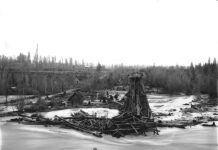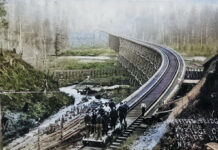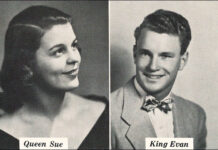It’s often been noted that postcards were the Instagram posts of their day. The original postcards were printed on cardstock and mailed individually to friends and relatives. The modern social media version is digitized into thousands of pixels—short for picture elements—and viewed simultaneously by hundreds. Pixels are the individual points of color that make up a digital image. Think of the French Impressionist George Seurat, who developed Pointillism, a technique that relies on the viewer to blend individual color spots into a full range of hues and tones.
This postcard was mailed on Sept. 21, 1908, from Black Diamond to Mrs. Meta (Spoerhase) Schloman at RFD #1 (Rural Free Delivery) Arlington, Washington. The message on the back states, “Will be home Oct. ?th 1908,” so it was perhaps from a family member. This image comes courtesy of JoAnne Matsumura, an Issaquah historian and photo collector. The black-and-white original was colorized by Boomer Burnham, a Tahoma High School photography instructor who operates commercially as Boomers Photography.
Mount Rainier was initially known as Tacoma by the Native Americans who lived in the area. There are several anglicized versions, including Tahkoma and Tacobet. But even those names were disputed in a 77-page inquiry to change the mountain’s moniker, held before the U.S. Geographic Board in May 1917. The official name is that given by George Vancouver in honor of his friend, Rear Admiral Peter Rainier. Rainier was an officer in the British Navy whose 50 years of service spanned the Seven Years’ War of 1856 to the Napoleonic Wars, which began in 1803. Efforts to change the name were unsuccessful, as there was no clear, universal Indian name, not surprising since different tribes lived near different slopes of the mountain and had various relationships with it.
Rainier is the tallest mountain in the Cascade Range and the fourth-highest in North America. It is also an active volcano with activity as recent as the 1800s. Mount Rainier’s most prominent legacy may be the lahar, or fast-moving flow of debris, that raced down the main fork of the White River about 5,600 years ago. That lahar, commonly known as the Osceola Mudflow, destroyed everything in its path, but it also created the Enumclaw Plateau and reached Puget Sound in several areas. It began as an avalanche or a series of avalanches near the mountain’s summit. They were caused by a period of eruptions that loosened an enormous landmass and raced down the mountain slope at speeds of 40 miles per hour.
Mount Rainier became a national park in 1899, the fourth established in the U.S. There are several main entrances, but the most widely visited areas are Paradise, Sunrise, and Longmire. The previous peak year for visitors was 1977, with 1.9 million visits. However, that was exceeded in 2023, when over 2.5 million visitors were recorded. Due to the post-COVID surge in visitors, timed-entry reservations were recently instituted at Paradise and Sunrise during the most popular period, from Memorial Day to Labor Day.
Some things never change – this view of Mount Rainier, driving south on S.R. 169 as you enter Black Diamond, is just as stunning today as it was in 1908.







